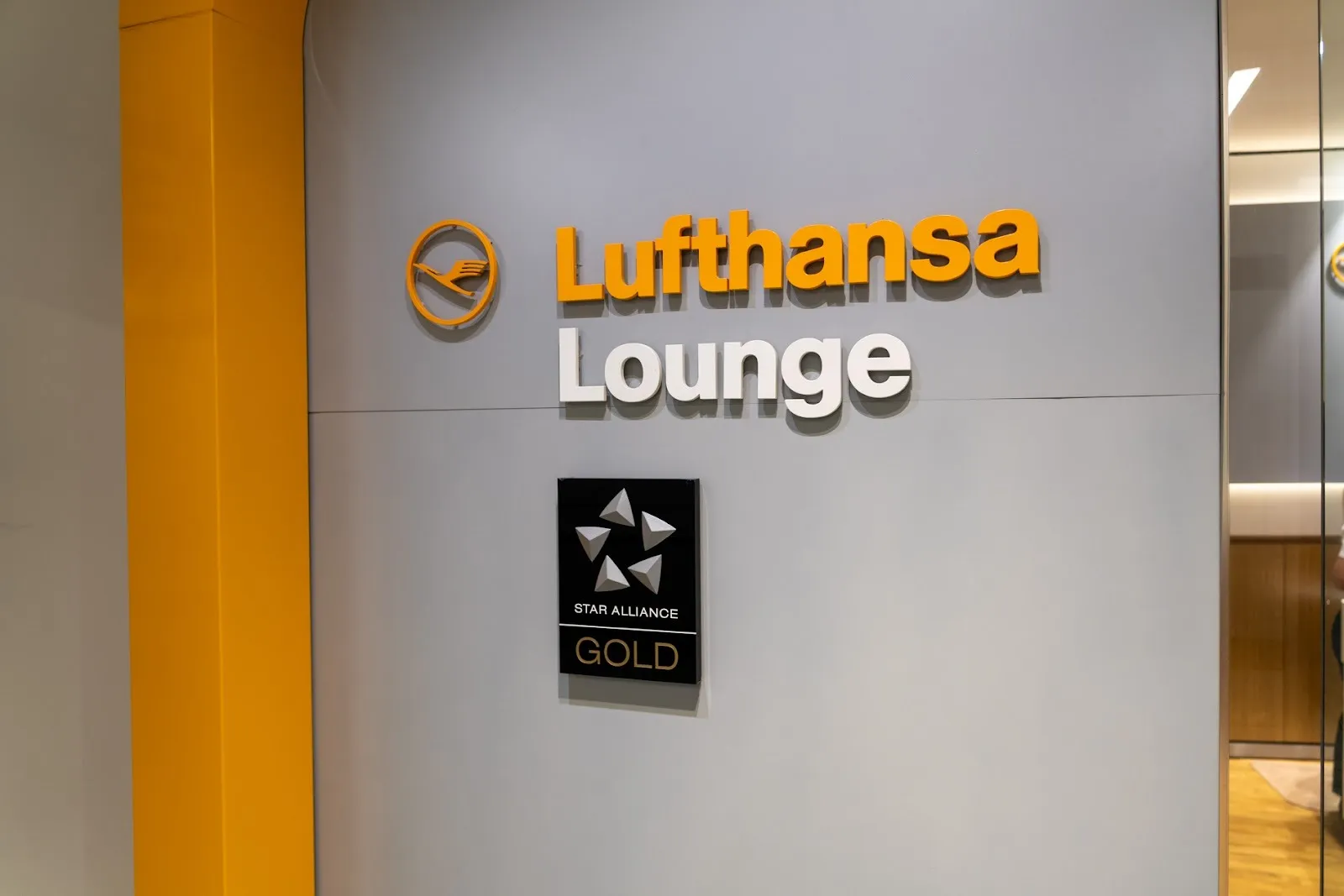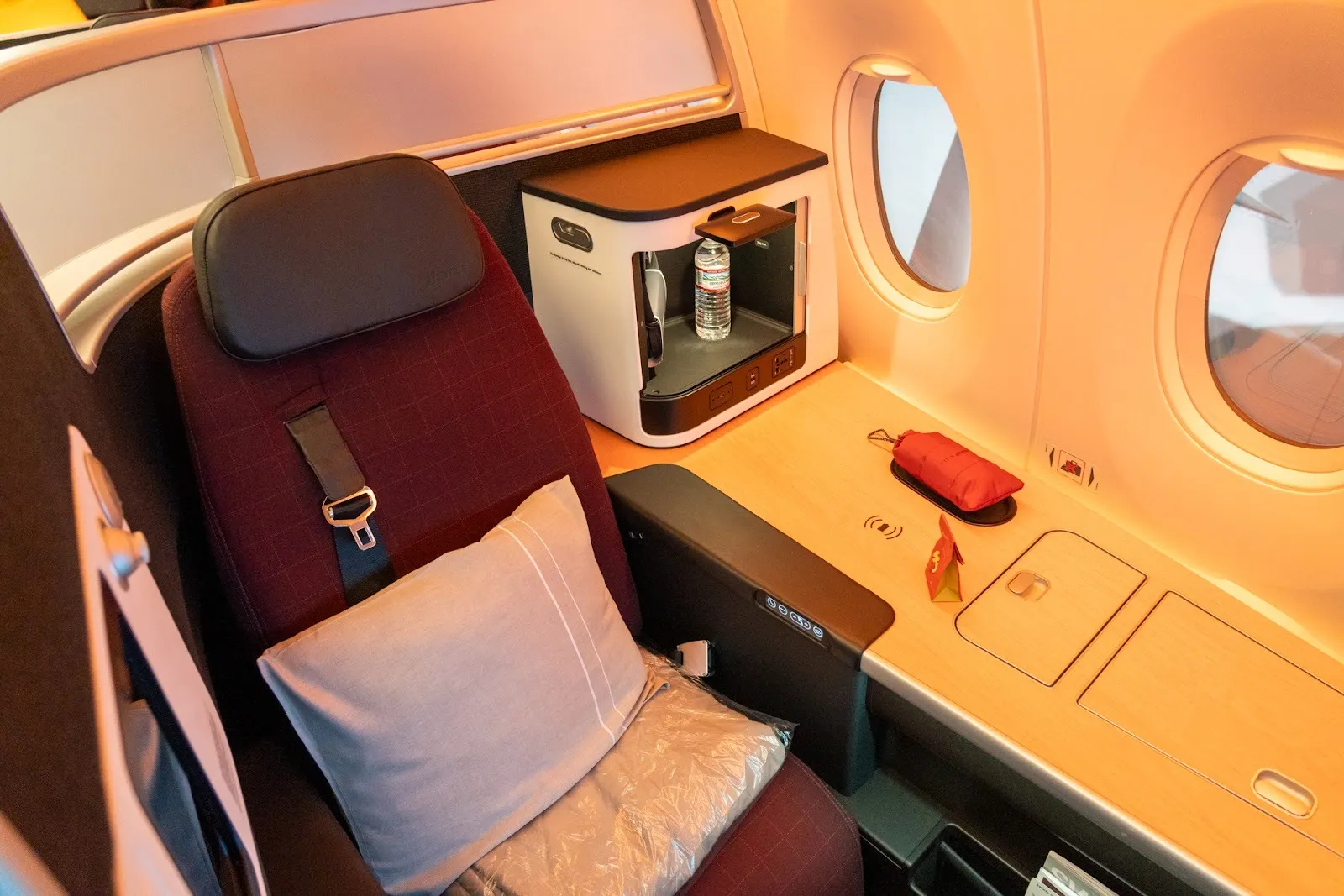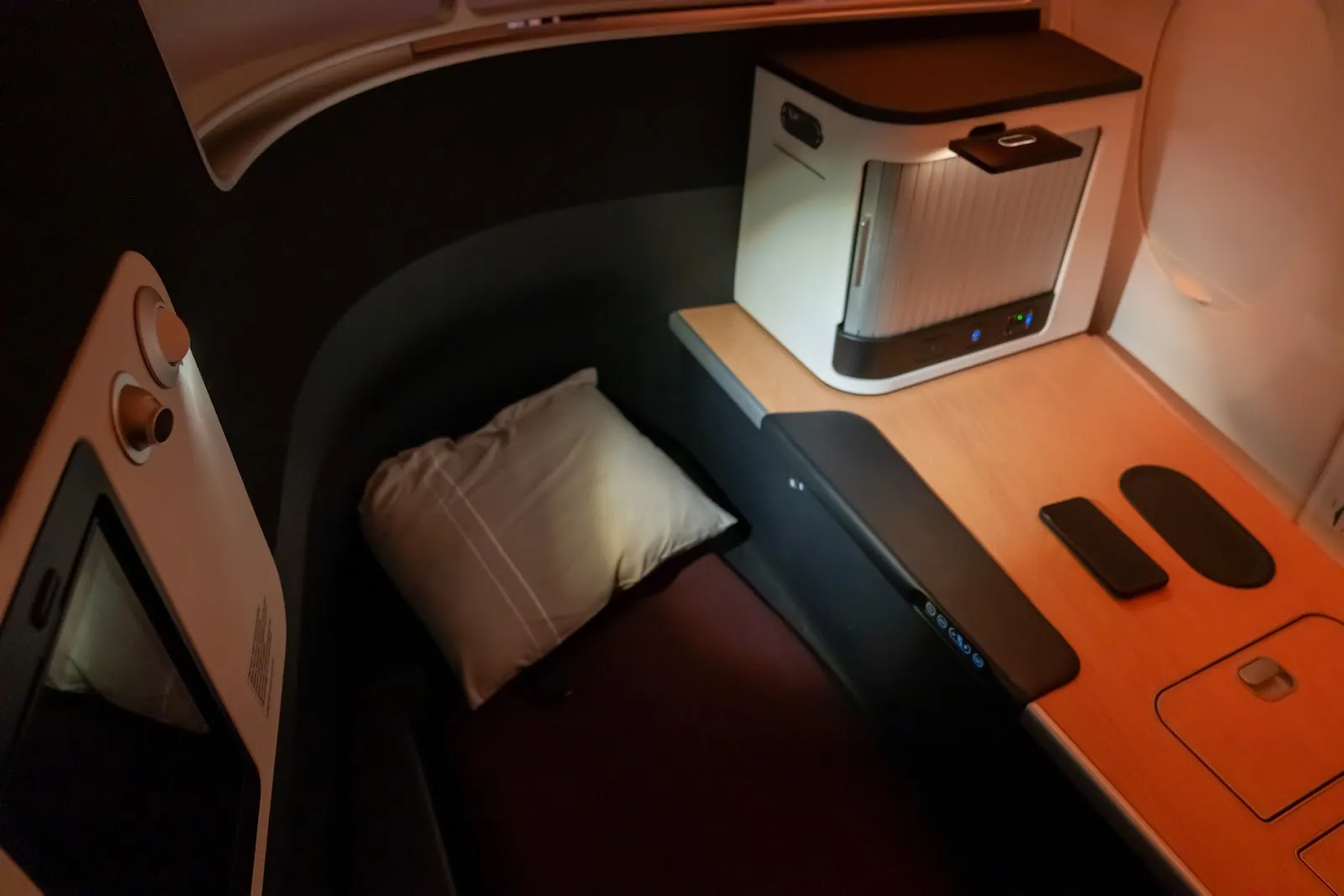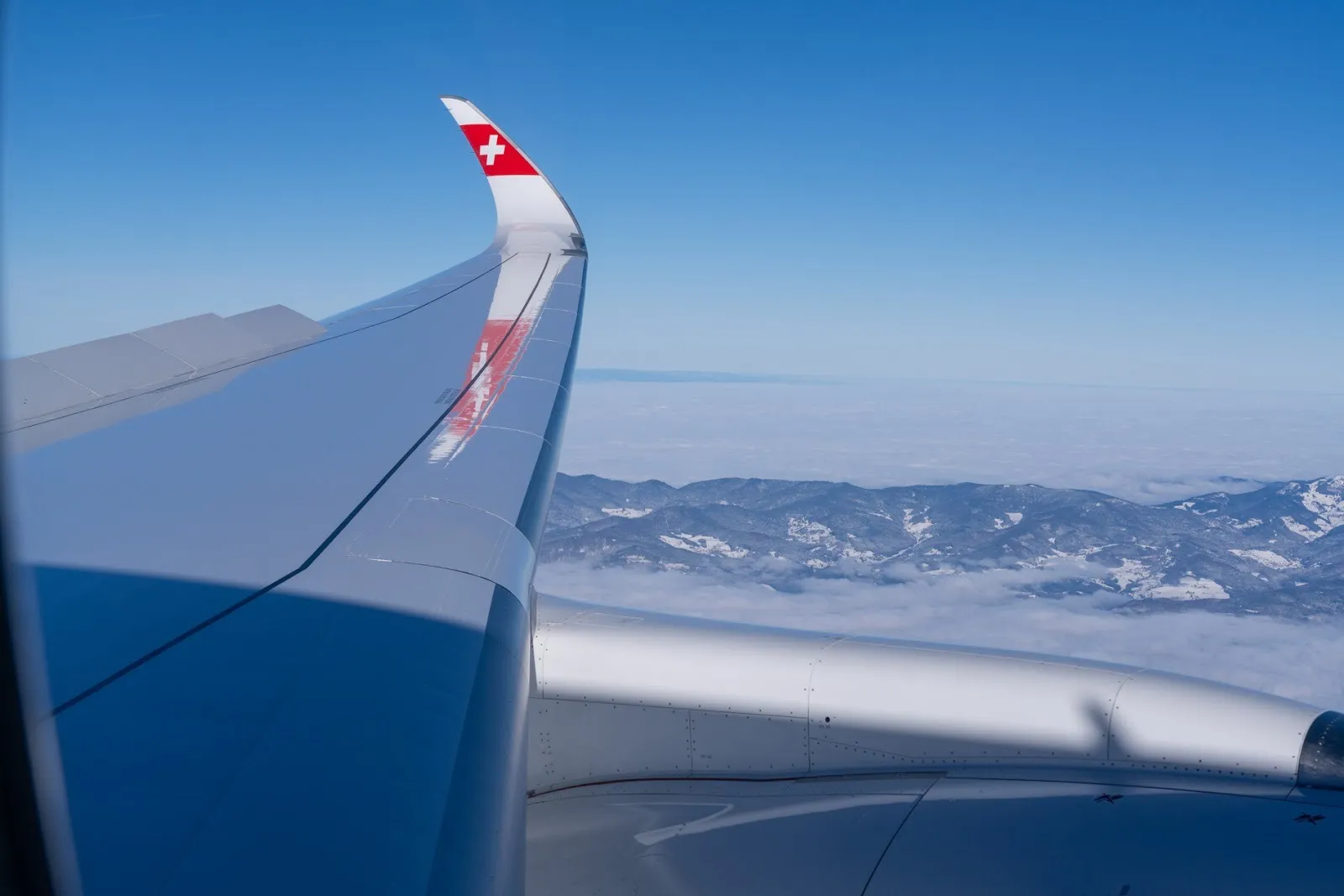BOSTON — On November 20, SWISS (LX) launched its long-haul A350-900 operations on flight LX52.
After joining the media delegation, it was soon time to return home after 24 hours in Boston. This gave me the occasion to try the Business Suite, the most premium Business Class seat in LX history.

At the Airport
Together with SWISS’s staff and journalists, we arrived at BOS Terminal E, where most international airlines operate. I quickly checked in my suitcase and received my boarding pass for seat 8A, the left Business Suite at the front of the rear Business Class cabin. Check-in took less than 2 minutes, including time spent filming our YouTube video, and we proceeded immediately to security controls, which also took about the same amount of time.
Passengers traveling with LX, and more generally with a Lufthansa Group airline, can access the dedicated Lufthansa Group lounge in Terminal E. This is located right across from gate E11 and is open every day from 12:15 pm to 9:30 pm. The lounge features all the amenities you’d expect from a high-end product and was still adorned with an inaugural painting of the first LX52 flight operated by the Airbus A350-900 from the day before.

The daily route was previously served by LX’s A330s and was chosen as the inaugural long-haul destination for the Airbus A350. Tonight’s flight would be the third-ever long-haul route operated by LX’s Airbus A350-900.


Since our flight was the last of the day, the lounge was relatively calm and quiet. The area features ample seating, a spacious buffet, and a manned bar. Celebrating the Airbus A350, a special cocktail was available for the occasion.
The eyecatcher, however, was the large Boeing 747-8i featuring the old Lufthansa brand identity, a favourite among the media delegation. A separate First Class section offers à la carte dining in a more private atmosphere. We relaxed here for just less than one hour before heading to our gate, just a few steps away.

I boarded HB-IFA, the first Airbus A350-900 to join LX, using facial recognition and headed straight to my seat, 8A. I had already checked this hard product on two occasions: the Airbus A350-900 world premiere in Zurich, and the inaugural flight from ZRH to BOS just the day before. I stored my backpack and suitcase in the dedicated overhead bin, took my cameras, and fastened my seat belts, ready to go back home in style.
Welcome Aboard
The seat’s benefits over the other four types are immediately noticeable. A large partition separates it from the rest of the cabin, providing greater privacy. Storage is paramount, with five large cabinets for everything from jackets to backpacks.
The seat also features a sliding door that unlocks after take-off for even more privacy. Unlike other seats, the ottoman in front is barely confined, and there are little to no restrictions on the bed’s height.

The power outlet, USB-A, and USB-C chargers are found underneath the upper storage cabinet and above the large console table. The wireless charger is also positioned conveniently next to the seat.
At my seat, I found the noise-cancelling headphones, a bottle of water, a welcome snack, and the amenity kit. Menus were distributed before pushing back on this short 6:05-hour flight back to Zurich. We were offered a welcome drink and taxied to the runway, ready to climb into the darkness.

Before dinner, I spent some time exploring the IFE system once again. Passengers can now connect their Bluetooth headphones and mobile devices to control the main screen and view the flight map.
The aircraft is equipped with five different cameras, which would be particularly useful for multiple landing views. The screen itself is a 24” OLED panel, larger than all seats other than the Extra Space “throne.” This can be controlled via a dedicated tablet positioned next to the seat, which mimics the main screen’s functions.
One detail I found unfortunate is that the IFE and tablet cannot be used simultaneously; it would have been nice to visualize the in-flight map on the tablet and a movie on the main screen.
The title selection is rather extensive and enjoyable on the 4K 24” OLED screen. The IFE also offers games, TV series, and a complete set of seat customisation options. Both IFE and seat settings were excellently designed and integrated into the system. A well-being area is also available, together with the SWISS Kids menu.
It was soon time for dinner, and I opted for the burrata appetizer and the seared beef tenderloin as the main. The first was a true cheese overload, something I rarely enjoy, and the second exceeded my expectations. Beef on aircraft can be a hit or miss, and I have had some underwhelming experiences in the past in all travel classes when flying overseas from the US. This time, it was a hit. The main course was perfectly cooked, tender, and as tasty as you’d expect it to be in a high-end restaurant. Dinner service was also attentive and efficient, with the cabin crew working particularly hard to serve the full cabin.


Immediately after dinner, I reclined my seat, lowered the armrest for additional space, and closed the door for almost four hours of sleep. Before departure, the captain informed us of some potentially strong turbulence during our Atlantic crossing. While you should always wear your seat belts, it was crucial to do so due to the high turbulence.

I woke up as we were approaching continental Europe, flying over the cloudy ocean towards Normandy. From now onwards, the views of the beautiful A350-900 winglet would accompany us until descent.
As the cabin crew noticed I was awake, they asked me if I wanted breakfast, as the service was still ongoing. I had a cup of tea, an espresso, and some pastries while staring at the horizon, checking traffic around us thanks to the fast Wi-Fi service.
We cross the French capital, one of the few areas not covered in clouds, before descending into Zurich after a beautiful approach over snowy lands. We touched down on runway 14 and taxied to gate E67 past a line of LX widebodies.


Conclusions
If one considers the A350-900 as the direct replacement for the A340-300 in SWISS’s fleet, the advantages really are self-explanatory—higher comfort, improved IFE, and connectivity in all travel classes. The Business Suite is the cherry on the cake of the refreshed Business Class experience, but it comes at a non-negligible price compared to other seats in the cabin.
The feeling is that of a First-Class suite: spacious, modern, and cozy, with ample space and storage. In fact, this seat features more storage options than LX’s old First-Class cabin, as well as better tech. For a long-haul flight, however, selecting this seat can cost several hundred dollars, and I don’t feel it would have been particularly worthwhile on a six-hour flight.
Surely, should the A350-900 be deployed to Los Angeles (LAX) or Tokyo Narita (NRT), the added space, privacy, and storage could be worth the additional fee. Passengers may also be lucky to leave seat selection to the last minute and hope to be randomly assigned to one of these ultra-premium seats.

There is also another point to make. The eight Business Suites have enabled SWISS to reduce the size of the First Class cabin compared to the Airbus A340-300. The old product featured eight seats over two rows, occupying valuable real estate space that could have been used for Business Class. In that sense, the Business Suite can attract passengers who would have opted for First Class but found the Business Suite deal more attractive and worthwhile.
Dedicating the front row of the Business Class cabin to a “Business+” product is becoming increasingly popular among airlines, with several in Europe already offering such products, and more in Asia and North America set to join soon. As far as the “Business+” seating category goes, there really is a slight improvement here.
Surely, the air vent could be quieter when only partially opened, and it would be nice to use both the IFE and remote simultaneously. However, considering the sheer amount of space and storage you get, it is hard to complain about these details.

All in all, the experience was as relaxed as it gets on such a short transatlantic flight. The Airbus A350’s fuel efficiency can be beneficial on longer-haul routes; however, LX would need to shrink part of its capacity to operate the type to airports such as LAX, SFO, NRT, and GRU.
We hope you found this trip report and analysis insightful, and thank you for reading this far. Stay tuned for more via our upcoming print issue. You can subscribe digitally on this website, just a few taps away!



.webp)
